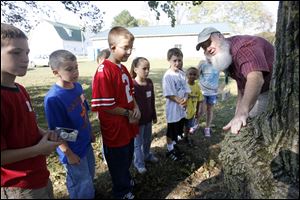
City kids get chance to taste rural life at conservation area
9/29/2010
Dennis Walsh, a naturalist volunteer, describes to students from Oakdale School the characteristics of one of hte trees at the Blue Creek Conservation Area.
exploring during blue creek days
As central-city kids connected to the countryside, they popped beans from pods, stroked the scaly skin of a snake, shucked corn, and dined in a barn. Not just any barn, but the biggest one in Lucas County.
During Blue Creek Days at the Blue Creek Conservation Area near Whitehouse last week, about 100 students, including 70 from Toledo Public Schools' Oakdale Elementary on East Broadway, explored acres of land that feature a quarry, lush garden, and examples of wetlands, prairies, and oak savannahs.
Blue Creek Days is a partnership program presented by Nature's Nursery Center for Wildlife Rehabilitation and Conservation Education; the Lucas Soil and Water Conservation District, and the Metroparks of the Toledo Area.
Hands-on activities vary by season. In the spring, students plant seeds in the International Children's Garden, and in the fall, students learn about vegetables and fruit growing in the garden, located in the former exercise area of what used to the Toledo Workhouse in Waterville Township.
On this sun-splashed morning, some students searched for a praying mantis in plants along a wall built decades ago by inmates who quarried the stone. Coils of rusty barbed wire still stretch along the wall.
Students learn not only about conservation, but some history on the workhouse. They were told how inmates grew crops for their food, Jamie Kochensparger said shortly after introducing a cluster of Toledo children to a plant as foreign to them as to soil in northwest Ohio. She is an education specialist with the Lucas Soil and Water Conservation District.
"How many of you are wearing blue jeans or T-shirts, and socks and underwear?" she asked, getting youngsters' heads to swivel to attention at the mere mention of "underwear." Arms shot up. Yep, they wear such clothing items.
Shrugs of "I don't know," followed when she asked what plant is used to make those items.
"Cotton," she said, snapping off a green pod from a cotton plant and showing the not-yet-dried white fiber.
Cotton not only is used to make clothing, but is ground to make cottonseed oil, she said, and cotton keeps dollar bills from falling apart when accidentally put through a wash cycle.
After the cotton-pickin' lesson, students dashed into rows of towering, rustling-in-the-wind stalks. Eagerly, they picked ears of rainbow-colored corn.
Typically, the city-dwelling youngsters are delighted to spend a day in the country, but get particularly giddy when they find out they can take home locally grown treasures, a teacher said.
"The kids always say, 'Oh, we get to bring things back,'•" fourth-grade teacher Karen McNaughton said.
Students clutched tomatoes, beans, eggplants, and ears of corn, treating garden bounty as highly prized gifts.
Dj Mears of Portage, an agriculture conservationist with the soil and water district, directed groups of students down rows of plants. During the peak season, the large, well-tended garden provides fresh produce for area food kitchens.
Trekking to Blue Creek is an annual and popular Oakdale tradition, Mrs. McNaughton said. "These are central-city kids. They haven't been out in nature like this. They haven't seen how things grow. They haven't walked at a quarry before," she said, noting the several-hour adventure enriches what students learn in the classroom. "It adds dimension. It is something phenomenal for the kids."
Students rotated from one learning area to another, and more than a few were thrilled to see, up close and personal, some animals nurtured by volunteers and staff at Nature's Nursery. A nonprofit organization near Whitehouse, it takes in about 2,000 native-to-Ohio animals each year, such as baby birds toppled from nests during wind storms.
As many animals as possible are released back into the wild, Nature's Nursery volunteer Carolyn Snyder of Perrysburg said.
Students learned about the lifestyles of several critters, including Marci the opossum. Fourth-grader Xerxes Means knew that Marci is nocturnal, meaning she "stays awake in the dark," like raccoons.
Blue Creek Days provide students with many opportunities to learn about conservation and habitat restoration efforts, about geology and ecology, and how people and nature coexist, Mrs. Kochensparger said.
It was cool to check out all the animals and plants, Javon Thomas, 9, said. "We learned not to litter and how to care for all the animals that live in the wild and live in the city," he said.